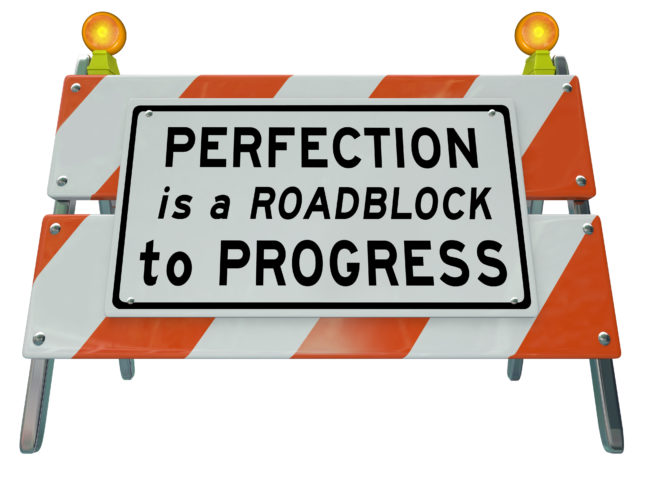Free Your Hands
 There was a FedEx commercial where a low-ranking employee suggests opening an online account to save shipping costs. No one responds. A few seconds later, the boss says exactly the same thing, only this time using emphatic gestures. Everyone cheers and adopts the solution. When the young guy points out that he suggested the same idea, the boss says: “But you didn’t go like this”, as he karate-chops the air.
There was a FedEx commercial where a low-ranking employee suggests opening an online account to save shipping costs. No one responds. A few seconds later, the boss says exactly the same thing, only this time using emphatic gestures. Everyone cheers and adopts the solution. When the young guy points out that he suggested the same idea, the boss says: “But you didn’t go like this”, as he karate-chops the air.
That scene may be a bit exaggerated, but the fact is that many speakers unconsciously disarm themselves by imprisoning their hands while they speak. They lose the effectiveness that gestures can contribute to the effectiveness of any presentation or conversation by supplying information, authenticity, and energy.
Information: Here’s a simple experiment you can do yourself to demonstrate the difference. Try giving someone complicated directions (go three blocks, then take a left and veer right at the fork…) without using gestures. It’s easier for the listener to envision spatial information because of the added clues provided by your gestures.
But it goes much further than that–gestures actually improve your ability to think while speaking. In Hearing Gesture, researcher Susan Goldin-Meadow says “Giving an explanation while gesturing actually takes less cognitive effort that giving an explanation without gesturing.” (p. 166) Speakers given more difficult speaking tasks gestured more, and they recalled more information.
There’s also evidence that it can help you be more fluent, although it’s not conclusive. Goldin-Meadow cites research that has found that speakers who were told to restrain their hands had more pauses. If that’s true, it might even help you limit your filler words.
Research results are unclear on whether gestures make it any easier for your audience to understand your message, but there is no evidence that gestures interfere with understanding.
Authenticity: Gestures can add credibility by indicating confidence and openness. First, they indicate the speaker’s confidence in his or her own message. On the minus side, people whose hands are hidden while they speak are seen as less credible, according to surveys assessing the credibility of lawyers and witnesses to jurors. There are also common gestures speakers use that indicate a lack of confidence (wringing your hands and touching your neck and face, for example). On the plus side, certain gestures can indicate high confidence on the part of the speaker, such as the forceful chopping gesture and steepling of the fingers. Second, keeping the hands and especially the palms visible indicates openness. As body language expert Joe Navarro (What Every Body Is Saying, p. 136) says: “When the hands are out of sight or less expressive, it detracts from the perceived quality and honesty of the information being transmitted.”
Research in courtrooms indicates that jurors find lawyers and witnesses less credible when they can’t see their hands. This makes evolutionary sense, as there is clear survival value in being able to see a potential opponent’s hands. It seems we’re hard-wired to pay close attention to hand movements.
Energy: Speakers who actively gesture seem more dynamic and hold the audience’s attention for longer. Gestures also have the effect of taking up more room, which is also perceived as a sign of confidence and dominance.
Here’s the problem with all this, though. If you make an active effort to incorporate strong gestures into your speaking style, you’re probably going to make a mess of it, unless you have a lot of practice. There is a false separation between verbal and non-verbal communication. Gestures are not separate from speech, they are a part of it. That’s why even people who have been blind from birth gesture when they speak. It’s completely natural, but that also means that without enough practice to make it automatic, you’re going to have to think about what you’re doing, and that’s going to guarantee that your gestures will be slightly mis-timed. Your listeners will perceive them as fake, even if they can’t consciously tell you why they feel that way. Trained actors with years of experience can do it, but you have a lot more important things to do with your time.
Since you don’t have all that time, there is one simple thing you can do which will take you 80% of the way there: just free your hands. Let them find their own natural level while you talk. When your hands are free to do what they want to do naturally, they get in synch with your words, and you come across as natural because you are natural. Whether you use large, sweeping movements or small subtle ones, they are who you are.
There are several ways that nervous speakers imprison their hands. Do you clasp your hands at crotch level in front of you? That’s called the fig-leaf. Maybe you clasp them behind you, making you look like you’re handcuffed. Hands folded across your chest make you look nervous and defensive, and hands in pockets are worst of all, especially when you start jingling coins or keys.
It’s OK to rest your hands in these positions briefly during a talk, but be sure you don’t do it too long. This might take a little practice (you can’t get away from that, can you?)
Free your hands and let them do what they want to do while you speak—they will definitely add power to your words. You look more confident, and you add life and fluency to your talk. If the eyes are a window on the soul, the hands help to open the front door.



